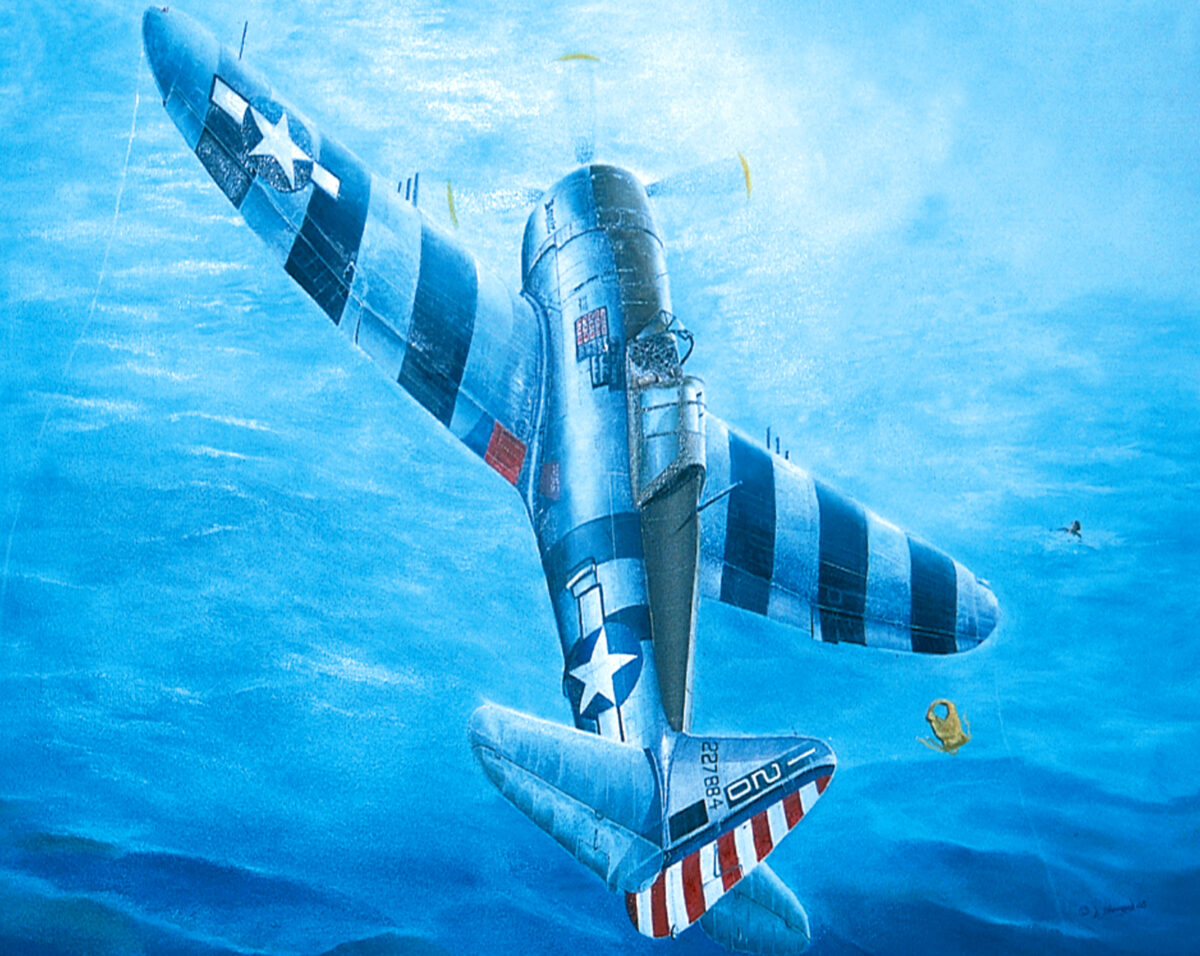David Hammond depicts Republic P-47D pilot Major Bill Dunham circling over a Japanese flier he had just shot down over the Philippine Sea in December 1944. Dunham is shown tossing his own lifejacket to the Nakajima Ki.43 “Oscar” pilot in the waves.
To fully appreciate Dunham’s actions, it’s necessary to trace the American airman’s combat career back a few months before that incident, to the previous March 6, when then-Captain Dunham was flying a patrol along with Captain Sam Blair and Colonel Neel Kearby near Wewak, off New Guinea’s northern coast. Kearby spotted what appeared to be three Kawasaki Ki.48 “Lily” twin-engine bombers from the 75th Sentai flying only about 500 feet above the water. When Kearby called for an attack, Dunham and Blair each made their run, downing their targets. Kearby did likewise, but then circled back—a serious mistake. The pilot of a Ki.43 from the 77th Sentai pounced on Kearby’s Thunderbolt, raking him with fire. Dunham then moved in behind the Oscar and fired his .50-caliber guns, downing the enemy plane.
Dunham and Blair circled the area but could see no trace of Kearby before they had to return to base for fuel. Dunham had to be physically restrained when he was told any further search for Kearby would be futile.
On December 7, now-Major Dunham was flying P-47D number 42-27884 Bonnie, leading a patrol of 10 aircraft from the 460th Fighter Squadron, 348th Fighter Group, against a formation of Ki.43s. Earlier that same day he had already downed two Mitsubishi A6Ms, and now he quickly flamed an Oscar. Its pilot managed to bail out before the aircraft crashed into the waves. Knowing that the Japanese often shot at Allied pilots as they hung beneath their parachutes, Dunham lined up on the Japanese airman. But then he changed his mind. He later told his wife Bonnie that it was “as if the Lord put his hand on my shoulder and said, ‘Bill, don’t do it.’” Dunham circled the downed pilot and then, seeing that he had no life jacket, pulled back his canopy and tossed out his own Mae West. It was a move he might well have regretted, since there were still enemy planes in the area.
By war’s end, Dunham was credited with 16 victories in P-47s and P-51s. He retired in 1970 as a brigadier general, having earned the Distinguished Service Cross, Silver Star, Legion of Merit, Distinguished Flying Cross, Air Medal and Air Force Commendation Medal. He died at age 70 in 1990.
Dunham’s story caught David Hammond’s eye when it was published in the King County (Washington) Journal in 2005. He worked closely with Bonnie Dunham, the late pilot’s wife, and Alex Morton, a docent at the Seattle Museum of Flight, to research the incident. Hammond became convinced that Dunham’s act “was a unique thing in a theater of war noted for its utter brutality.” They also discovered what had happened to Neel Kearby. In 1946 the remains of an American pilot found on New Guinea were identified as Kearby’s. An autopsy determined he had apparently survived long enough to bail out, but succumbed to bullet wounds while dangling from his parachute. He had died because a flier fired on a downed enemy—as Dunham later refused to do.
Hammond re-created Dunham’s P-47D in model form, then shot a series of color slides and projected them onto his canvas, “to get an accurate outline of the aircraft in just the right pose.” He presented the completed painting to Bonnie Dunham. Currently on loan to the Seattle Museum of Flight, it is displayed in the “Personal Courage Wing.”
Originally published in the May 2008 issue of Aviation History. To subscribe, click here.





